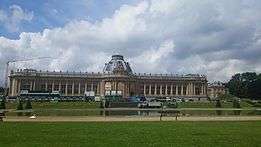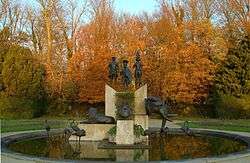Royal Museum for Central Africa
 The building housing the museum, view from the park at the entrance to the museum. | |
 Location within Belgium | |
| Established | 1898 |
|---|---|
| Location | Tervuren, Belgium |
| Coordinates | 50°49′51″N 4°31′07″E / 50.830889°N 4.518497°E |
| Type | Ethnography, Natural History and History museum |
| Director | Guido Gryseels (2001-present) |
| Public transit access | 44 Tram Line |
| Website |
www |
The Royal Museum for Central Africa or RMCA (Dutch: Koninklijk Museum voor Midden-Afrika or KMMA; French: Musée royal de l'Afrique centrale or MRAC), colloquially known as the Africa Museum, is an ethnography and natural history museum situated in Tervuren in Flemish Brabant, Belgium, just outside Brussels. It was first built to showcase King Leopold II's Congo Free State in the 1897 World Exhibition.
The museum focuses on the Congo, a former Belgian colony. The sphere of interest however (especially in biological research) extends to the whole Congo River basin, Middle Africa, East Africa and West Africa, attempting to integrate "Africa" as a whole. Intended originally as a colonial museum, from 1960 onwards it has more focused on ethnography and anthropology. Like most museums, it houses a research department in addition to its public exhibit department.
Not all research pertains to Africa (e.g. research on the archaeozoology of Sagalassos, Turkey). Some researchers have strong ties with the Royal Belgian Institute of Natural Sciences.
As of November 2013, the museum is closed for renovation work (including the construction of new exhibition space) which is expected to last until 2017 when the museum will reopen.[1]
History


After his Congo Free State was recognized by the Berlin Conference of 1884–1885, King Leopold II wanted to publicise the civilizing mission and the economic opportunities available in the colony to a wider public, both in Belgium and internationally. After considering other places, the king decided to have a temporary[2] exhibition in his royal estate at Tervuren. When the 1897 International Exposition was held in Brussels, a colonial section was built in Tervuren, connected to the city centre by the monumental Avenue de Tervueren. The Brussels-Tervuren tram line 44 was built at the same time as the original museum by King Leopold II to bring the visitors from the city centre to the colonial exhibition. The colonial section was hosted in the Palace of the Colonies (Palais des colonies). The building was designed by the Belgian architect Albert-Philippe Aldophe and the classical gardens by French landscape architect Elie Lainé. In the main hall Georges Hobé designed a distinctive wooden Art Nouveau structure to evoke the forest, using Bilinga wood, an African tree. The exhibition displayed ethnographic objects, stuffed animals and Congolese export products (coffee, cacao and tobacco). In the park, a temporary "Human zoo" - a copy of an African village - was built, in which 60 Congolese people lived for the duration of the exhibition. The exposition was a huge success.

In 1898 the Palace of the Colonies became the Museum of the Congo (Musée du Congo) and a permanent exhibition was installed. A decade later, in 1912, a small, similar museum - the African Museum of Namur (Musée africain de Namur) - was opened in Namur. The Museum began to support academic research, but due to the avid collecting of the scientists, the collection soon grew too large for the museum and enlargement was needed. Tervuren became a rich suburb of Brussels. The new museum started construction in 1904 and was designed by the French architect Charles Girault in neoclassical "palace" architecture, reminiscent of Petit Palais in Paris, with large gardens extending into the Tervuren Forest (a part of the Sonian Forest). It was officially opened by King Albert I in 1910 and named the Museum of the Belgian Congo (Musée du Congo Belge or Museum van Belgisch-Kongo). In 1952 the adjective "Royal" was added. In preparation for Expo '58, in 1957 a large building was constructed to accommodate African personnel working in the exhibition: the Centre d'Accueil du Personnel Africain (CAPA). In 1960, following the independence of the Congo, the museum's name was changed to its current title: the Royal Museum for Central Africa.
In late 2013 the museum was closed to allow a major renovation of its exhibits and an extension. Its reopening is planned for 2017.[2]
Collections
According to the website of the museum,[3] the collection contains:
- 10,000,000 animals
- 250,000 rock samples
- 120,000 ethnographic objects
- 20,000 maps
- 56,000 wood samples
- 8,000 musical instruments
- 350 archives, including some of Henry Morton Stanley's journals
The herbarium collection of the Congo Museum was transferred to that of the National Botanic Garden of Belgium in 1934.
Research
The publicly accessible museum itself only represents 25 percent of the activities which the museum covers.[1] The scientific departments, which represent the bulk of the museum's academic and research facilities, (together with the main collections) are housed in the Palace of the Colonies, the Stanley Pavilion and in the CAPA building.
There are 4 departments:
- Department of Cultural Anthropology
- Ethnography
- Archaeology and Prehistory
- Linguistics and Ethnomusicology
- Anthropology and Ethnohistory
- Department of Geology and Mineralogy
- General Geology
- Mineralogy and Petrography
- Cartography and Photo interpretation
- Physical and Mineral chemistry
- Department of Zoology
- Vertebrates (Ornithology, Ichthyology, Herpetology, Osteology and Mammalogy)
- Entomology
- Invertebrates non-insects (Arachnology, Myriapodology, Acarology)
- Department of History and General Scientific Services
- History of the Colonial Period
- Contemporary History
- Agricultural and Forest economics (Geomorphology, Laboratory of Wood Biology)
Controversy

There has been controversy surrounding the Museum. It had been called a museum that "has remained frozen in time"[2] as it showed how a museum looked like in the mid-twentieth century. No mention was made of the savage excesses and pillage during Belgium's colonial era.[2]
The Guardian reported in July 2002 that, after initial outrage by Belgian historians over King Leopold's Ghost by Adam Hochschild, the state-funded museum would finance an investigation into Hochschild's allegations. The resulting more modern exhibition "The Memory of Congo" (February–October 2005), tried to tell the story of the Congo Free State before it became a Belgian colony and a less one-sided view of the Belgian colonial era.[2] The exhibition was praised by the international press, with French newspaper Le Monde claiming that "the museum has done better than revisit a particularly stormy page in history...[it] has pushed the public to join it in looking into the reality of colonialism."[4]
Gallery

See also
References
- 1 2 "During the renovation". Africamuseum.be. Retrieved 16 June 2013.
- 1 2 3 4 5 McDonald-Gibson, Charlotte (2013-11-29). "Belgian museum faces up to its brutal colonial legacy". The Independent. Retrieved 2016-05-17.
- ↑ "Unique and priceless heritage An overview of our collections". africamuseum.be. Retrieved 10 November 2012.
- ↑ "La Belgique confrontée à la violence de son aventure coloniale au Congo". Le Monde. 26 February 2005.
External links
| Wikimedia Commons has media related to Royal Museum for Central Africa. |
- Official museum site
- Collection etnomusicology
- Tervuren wiki page on the museum Archived 26 February 2007 at the Wayback Machine.
- Mémoires des Rites Populations of Central Africa-in French but excellent pictures of ethnographic material from RMCA Tervuren.
- Flickr Images tagged RMCA
- Albertine Rift Project To access the many excellent pictures Pick a group (bird, butterfly fish) in top menu then go to the taxa list. Click on the species name if a photo is indicated by a camera pic on the right.
- "Retelling the Story" article in Flanders Today
Coordinates: 50°49′51.20″N 4°31′6.59″E / 50.8308889°N 4.5184972°E